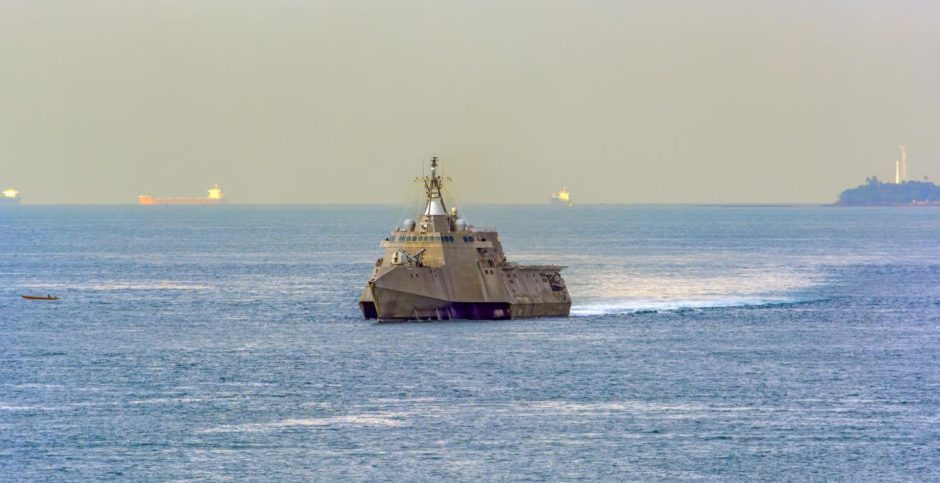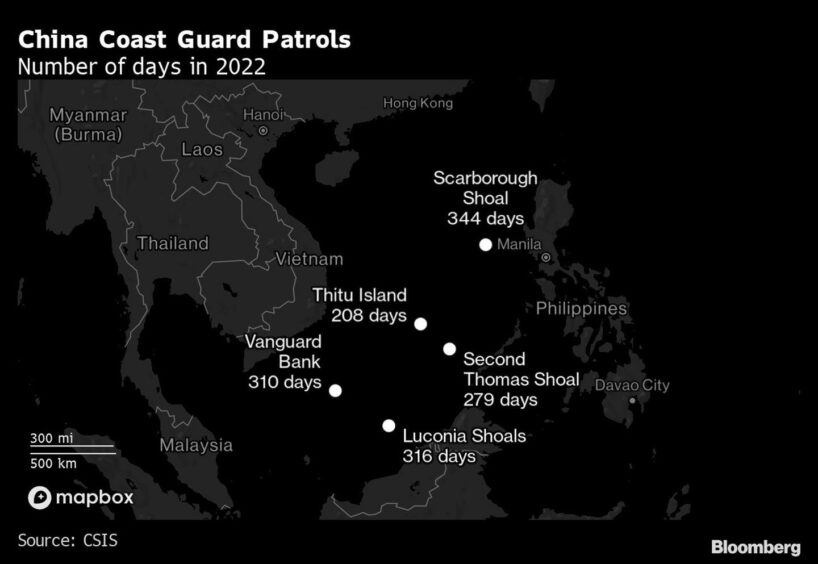
China’s Coast Guard maintained near-daily patrols at key features across the disputed South China Sea last year, ramping up its presence as tensions over the waterway with Southeast Asian neighbours remain high, new tracking data shows.
Patrols in the waters surrounding the Vanguard Bank off Vietnam, an area known for its oil and gas reserves and the site of repeated standoffs between Chinese and Vietnamese vessels, more than doubled to 310 days in 2022, according to the Washington-based Asia Maritime Transparency Initiative.
The number of days Chinese ships patrolled near Second Thomas Shoal in the Spratly Islands, where the Philippines maintains a garrison, increased to 279 from 232, while those at Luconia Shoals, near important Malaysian oil and gas operations, rose to 316 from 279, according to the analysis.
The patrols show Beijing’s determination to assert control over its claim to more than 80% of the South China Sea, the analysis of ship identification data says, and raises the risk of a mishap at sea that regional officials worry could lead to a larger conflict.
“With CCG vessels operating in Malaysian, Philippine and Vietnamese waters every day of the year, it all but guarantees tensions remain high and run-ins with those neighbours a regular occurrence,” said Greg Poling, head of the Southeast Asia program at Washington’s Center for Strategic and International Studies.
The report said its count of Chinese incursions are probably incomplete, because not all ships employ the transceivers used to track their whereabouts. And some try to obscure their identities with false data, it added.
Poling said the Chinese patrols are becoming a fact of life in the region: “The patrol locations have been extremely consistent in recent years, creating a predictable status quo that the Southeast Asian parties can manage, albeit with difficulty.”

The analysis of China’s actions comes as US Secretary of Defense Lloyd Austin makes his sixth trip to the Indo-Pacific region this week. The Pentagon chief will meet with his counterpart in South Korea in an effort to strengthen the security environment in the region. Austin is then expected to visit the Philippines, where he’s poised to secure expanded access to key military bases, the Washington Post reported, adding that negotiations are still ongoing.
The number of high-level engagements between Washington and Manila has increased under President Ferdinand Marcos Jr. and the two sides have agreed to speed up existing military projects and undertake new ones under an existing defence pact.
The Southeast Asian nation last month ordered the military to strengthen its presence in the South China Sea after repeatedly voicing displeasure with incursions by China’s People’s Liberation Army. Vietnam and Indonesia are also bolstering their own defences.
A senior US defence official said this month that the PLA has generally become more reckless toward US and allied partners in the South China Sea as it increases its military capacity, directing chaff toward other planes and having its ships cut across the bows of foreign vessels.
The same official said the Pentagon is struggling to get Beijing to resume military-to-military talks after the PLA last month held its largest drills near Taiwan since the unprecedented exercises that followed then-House Speaker Nancy Pelosi’s 2022 visit.
“When there’s no trust, when there’s no communication between nations, when you have two fighter jets flying closely in the air like we had very recently over the South China Sea, that could escalate very quickly if one of the pilots has a quick trigger and makes a mistake,” said Stephen Roach, author of “Accidental Conflict.”